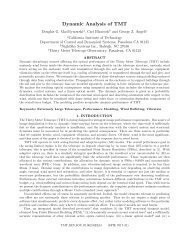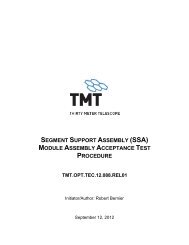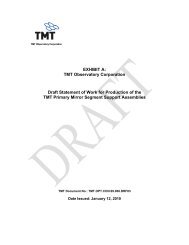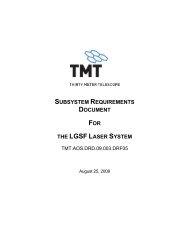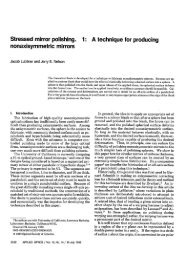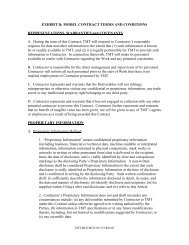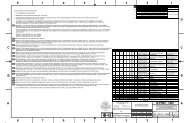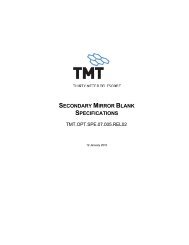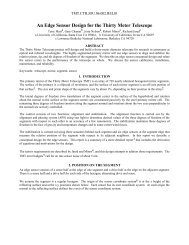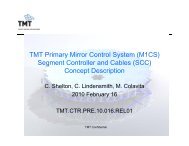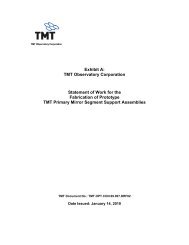Advancement of the Segment Support System - Thirty Meter Telescope
Advancement of the Segment Support System - Thirty Meter Telescope
Advancement of the Segment Support System - Thirty Meter Telescope
You also want an ePaper? Increase the reach of your titles
YUMPU automatically turns print PDFs into web optimized ePapers that Google loves.
Adhesive layer<br />
Diaphragm<br />
Optical Surface<br />
Diaphragm<br />
Glass<br />
Glass<br />
Moving<br />
Frame<br />
Diaphragm Outer Rim<br />
Figure 9<br />
Cross-section view showing diaphragm outer rim bonded to <strong>the</strong> glass segment at <strong>the</strong> bottom <strong>of</strong> a<br />
machined pocket, and bolted connection between diaphragm center hub and moving-frame.<br />
4.1 Diaphragm Concepts<br />
All <strong>of</strong> <strong>the</strong> diaphragm concepts studied share three basic features. Each has a center hub which provides a stiff, strong<br />
connection to <strong>the</strong> moving-frame via a bolted connection. Each diaphragm also has a thin flexible region that is outboard<br />
<strong>of</strong> <strong>the</strong> hub. This thin region is sized to provide <strong>the</strong> greatest amount <strong>of</strong> axial compliance, while retaining sufficient lateral<br />
stiffness, strength, and elastic stability to support <strong>the</strong> segment during operation and survival events such as handling,<br />
transportation, and seismic. The third common feature is a thickened outer rim that is bonded to <strong>the</strong> glass. The thicker<br />
section is included to improve load transfer, minimize bond peel stress, and ease manufacturing and assembly. There is<br />
a recessed area between <strong>the</strong> glass and <strong>the</strong> thin flexible region to permit <strong>the</strong> diaphragm to deflect during operation without<br />
contacting <strong>the</strong> glass at <strong>the</strong> bottom <strong>of</strong> <strong>the</strong> pocket.<br />
In this discussion, temperature increases affecting <strong>the</strong> system will be referenced, recognizing that a temperature decrease<br />
causes <strong>the</strong> opposite response. When subject to a temperature increase, <strong>the</strong>rmal mismatch loads develop between <strong>the</strong><br />
glass and <strong>the</strong> diaphragm as <strong>the</strong> diaphragm tries to expand radially, while <strong>the</strong> expansion is resisted by <strong>the</strong> low expansion<br />
glass. A design that minimizes <strong>the</strong> effects <strong>of</strong> CTE mismatch is sought. In this light, <strong>the</strong> three diaphragm designs shown<br />
in Figure 10 were considered. All three designs are fabricated from a single piece <strong>of</strong> Invar. Their features and inherent<br />
characteristics will be described, and <strong>the</strong>n <strong>the</strong> analysis results that lead to selecting <strong>the</strong> preferred design for TMT will be<br />
presented.<br />
The first diaphragm concept (Option-1) is a simple, flat diaphragm, having a continuous outer rim. This diaphragm is<br />
<strong>the</strong> simplest and lowest cost design. Analysis shows that it produces <strong>the</strong> largest CTE mismatch loads, and hence largest<br />
stress and optical distortion as <strong>the</strong> temperature changes. When subject to lateral gravity, this diaphragm transfers loads<br />
in an effective manner, helping minimize distortion <strong>of</strong> <strong>the</strong> optical surface.<br />
The second diaphragm concept (Option-2) was developed to reduce <strong>the</strong> CTE mismatch effects by adding two additional<br />
features. First, <strong>the</strong>re is an axisymmetric convolution extending around <strong>the</strong> perimeter near <strong>the</strong> outside diameter <strong>of</strong> <strong>the</strong><br />
flexible region. This flexible convolution allows <strong>the</strong> thin flat region <strong>of</strong> <strong>the</strong> diaphragm to expand radially, without<br />
imparting significant radial forces into <strong>the</strong> glass. Second, <strong>the</strong> outer rim has a pattern <strong>of</strong> radial slots that interrupt <strong>the</strong><br />
hoop continuity <strong>of</strong> <strong>the</strong> outer rim, greatly reducing <strong>the</strong> loads transmitted into <strong>the</strong> glass. The combination <strong>of</strong> <strong>the</strong><br />
convolution and <strong>the</strong> slots results in a very low stress design in terms <strong>of</strong> CTE mismatch. Stiffness and strength are only<br />
slightly degraded for this design, but <strong>the</strong> part is more complex and costly to fabricate. Additionally, <strong>the</strong> slotted rim<br />
results in a set <strong>of</strong> tabs that must be bonded to <strong>the</strong> glass, ra<strong>the</strong>r than <strong>the</strong> continuous rim <strong>of</strong> <strong>the</strong> first concept. Analysis<br />
shows this design to be extremely good from a <strong>the</strong>rmal distortion standpoint, compared to <strong>the</strong> first design, but deficient<br />
when subject to lateral gravity.<br />
The third diaphragm concept (Option-3) is a compromise between <strong>the</strong> first two designs, having a slotted outer rim, but<br />
no convolution. Analysis shows this design to have moderately better <strong>the</strong>rmal distortion, compared to <strong>the</strong> first design,<br />
and essentially <strong>the</strong> same optical performance when subject to lateral gravity.



